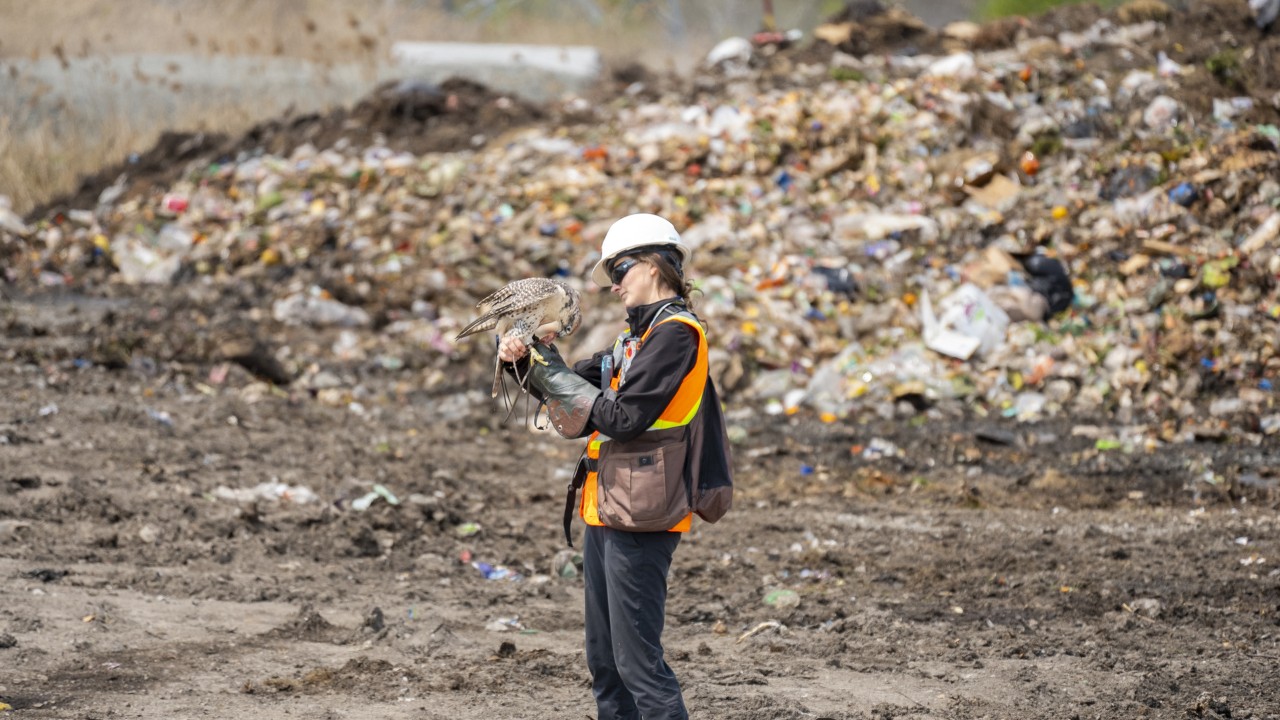Montreal's Biosphere will be showing an immersive, spherical film by Concordia faculty and students for the next 9 months
 Stéphanie Mercure with her falcon at Lachenaie landfill. Credit: Vincent Donze
Stéphanie Mercure with her falcon at Lachenaie landfill. Credit: Vincent Donze
What can seagulls teach us about the levels of toxic chemicals all around us? According to the Concordia-produced immersive film As the Gull Flies, quite a lot.
Every spring, 70,000 ring-billed gulls come to breed on Île Deslauriers, a small island in the Saint Lawrence River just east of Montreal.
This makes it one of the largest colonies of gulls in North America. But where there's human settlement, there is inevitably tension with the natural world.
The gulls feed at the nearby Lachenaie landfill, the largest landfill in Canada. Local residents are annoyed by the mess and disturbance created by the bird’s flight path between the island and the landfill. Aside from being a nuisance to nearby residents, the birds are exposed to a number of toxic chemicals found in trash and discarded items.
Having gained access to the island and the landfill, UQAM scientist Jonathan Verreault and a team of researchers have been tracking the gulls and measuring the levels of flame-retardants and other chemicals found in them, seeing if their behaviour or flight paths are altered.
"We've seen a lot of variation in the spatial behaviour of these urbanized gulls who've been exposed to contaminants," says Anna Lippold, one of the researchers featured in the film. "But we don't yet know exactly why."
In order to learn more, Verreault and his team have been fitting the gulls with homemade backpacks that include an air-quality sampler and a GPS, while Lippold has been testing their ability to navigate back to the colony from different locations.
 Communication Studies student Vincent Donze filming researchers on Île Deslauriers. Credit: Liz Miller
Communication Studies student Vincent Donze filming researchers on Île Deslauriers. Credit: Liz Miller
A unique media space to address environmental issues
A team of Concordia faculty and Communication Studies students filmed the collaborative operation, using the unique setting and material to create a cutting-edge, immersive film tailor-made for the Montreal Biosphere's unique 360-degree projection space.
"We had to adapt our footage to the 360 screen," says Vincent Donzé, a Concordia undergrad in communications who was the cinematographer for the film. "During the editing we had to use up to three different shots and join them together while keeping the timeline clear. It's immersive and poetic and visually beautiful."
Viewers are completely surrounded by a ring of screens and speakers, and the effect is of being transported into the thick of the gull colony alongside the scientists.
"The film is hybrid in its immersive character and its desire to integrate data, surround-sound and diverse media forms," says Liz Miller, a professor of Communications Studies and director of the collaborative film.
"The purpose of the film is to heighten our awareness of the relationship between humans and other species, and how we each negotiate the enormity of waste in our lives."
The twin facets of the film, combining environmental science with cutting-edge media techniques, appealed to Miller.
"The venue is a science museum, and our challenge was to present the topic in a clear and compelling way, but also to try to bring some poetics to it — so that you can feel something for the birds and walk away with a new perception or awareness of this entangled relationship."
A collaborative scientific effort
While As the Gull Flies was filmed and put together by a team from Concordia, studies into the colony are a collaborative effort involving students and specialists from McGill University and UQAM as well as local wildlife control officers.
Stéphanie Mercure, also featured in the film, addresses the gull human conflict from a different angle. She works at the landfill as a falconer who trains her birds to discourage the seagulls from feeding at the landfill.
"There is a serious dilemma about what to do with this onslaught of seagulls in this toxic site," Miller explains. "It’s not good for the gulls nor is it good for the workers who are operating big machines and whose vision is obstructed by the thousands of gulls.” But using falcons as a deterrent is a more humane way to try to impact things.
As the Gull Flies harnesses the power of immersive media to convey a complex social and scientific issue, asking the question, Who is the real waste animal in this equation?
The film is part of a larger research and pedagogical initiative, called WasteScapes, that was initiated by Liz Miller and MJ Thompson.
As the Gull Flies is screening now at the Biosphere (160 chemin Tour-de-l'Isle on Île Sainte-Hélène) until April 28, 2024.
Wastescapes is also leading a series of four walking tours on Île Sainte Helene in collaboration with The Biosphere and Campus de la Transition. The tours are taking place July 6, July 20, August 3 and August 24.

